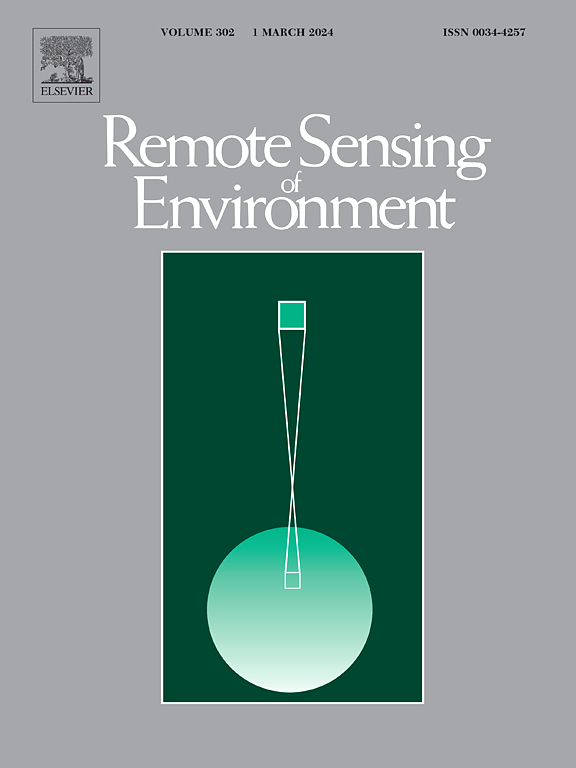Evaluating rainfall and graupel retrieval performance of the NASA TROPICS pathfinder through the NOAA MiRS system
IF 11.1
1区 地球科学
Q1 ENVIRONMENTAL SCIENCES
引用次数: 0
Abstract
The NASA TROPICS mission encompasses a constellation of CubeSats equipped with microwave radiometers, dedicated to investigating tropical meteorology and storm systems. In a departure from traditional microwave sounders, the TROPICS Microwave Sounder (TMS) employs new frequencies at F-band near 118 GHz and features an additional G-band channel at 205 GHz. We have expanded the capabilities of the Microwave Integrated Retrieval System (MiRS), a state-of-the-art one-dimensional variational (1DVAR) algorithm, for the retrieval of geophysical variables with the TROPICS Pathfinder early-phase data. Here we focus on assessing the retrieved precipitation in terms of rainfall and graupel. TROPICS captures well the spatial distribution and temporal evolution of Hurricane Ida and Super Typhoon Mindulle. TROPICS depicted the eyewall replacement cycle of Mindulle as it weakened and reintensified. The global precipitation distribution and dynamics are well represented by TROPICS. We compare TROPICS with other precipitation datasets, including Global Precipitation Mission (GPM) GPM Microwave Imager (GMI) and Dual-Frequency Precipitation Radar (DPR) products. For example, when compared with GMI, MiRS TROPICS instantaneous precipitation yields a correlation coefficient of 0.5 and an RMSE of 2.0 mm/h. For graupel, MiRS TROPICS retrievals show a correlation of 0.52 and an RMSE of 0.53 kg/m2. The retrieval performance is comparable to other sensors such as the Advanced Technology Microwave Sounder (ATMS), while the higher number of channels of ATMS, including its low-frequency channels serve to better constrain retrievals. TMS observes at higher spectral frequencies than the coincident ATMS channels, showing higher sensitivity to rainfall and graupel. The TMS high-frequency channels and lower orbit allow for greater resolution of precipitation features, while lower-frequency ATMS channels excel at resolving hurricane warm-core structures. The results underscore the value of the TROPICS mission for precipitation measurement and demonstrate the successful integration of TROPICS processing capability within the MiRS retrieval algorithm framework.通过NOAA MiRS系统评估NASA热带探路者的降雨和霰检索性能
美国国家航空航天局的 TROPICS 任务包括一个配备微波辐射计的立方体卫星星座,专门用于调查热带气象学和风暴系统。与传统的微波探测仪不同,TROPICS微波探测仪(TMS)采用了F波段接近118千兆赫的新频率,并增加了一个205千兆赫的G波段通道。我们扩展了微波综合检索系统(MiRS)的功能,这是一种最先进的一维变分(1DVAR)算法,用于利用 TROPICS 探路者早期阶段数据检索地球物理变量。在此,我们重点从降雨和砂砾岩的角度对检索到的降水量进行评估。TROPICS 很好地捕捉了飓风 "艾达 "和超强台风 "明都尔 "的空间分布和时间演变。TROPICS 描述了 "明都 "在减弱和重新加强过程中的眼球替换周期。TROPICS 很好地表现了全球降水的分布和动态。我们将 TROPICS 与其他降水数据集,包括全球降水任务(GPM)微波成像仪(GMI)和双频降水雷达(DPR)产品进行了比较。例如,与 GMI 相比,MiRS TROPICS 瞬时降水量的相关系数为 0.5,均方根误差为 2.0 毫米/小时。对于谷雨,MiRS TROPICS 的检索结果显示相关系数为 0.52,有效误差为 0.53 kg/m2。检索性能与先进技术微波探测仪(ATMS)等其他传感器相当,而 ATMS 的信道数量较多,包括其低频信道,有助于更好地限制检索。TMS 观测的频谱频率高于 ATMS 的重合通道,对降雨和岩浆的灵敏度更高。TMS 的高频信道和较低的轨道使得降水特征的分辨率更高,而 ATMS 的低频信道则在解析飓风暖核结构方面表现出色。这些结果强调了 TROPICS 任务在降水测量方面的价值,并证明 TROPICS 处理能力与 MiRS 检索算法框架的成功整合。
本文章由计算机程序翻译,如有差异,请以英文原文为准。
求助全文
约1分钟内获得全文
求助全文
来源期刊

Remote Sensing of Environment
环境科学-成像科学与照相技术
CiteScore
25.10
自引率
8.90%
发文量
455
审稿时长
53 days
期刊介绍:
Remote Sensing of Environment (RSE) serves the Earth observation community by disseminating results on the theory, science, applications, and technology that contribute to advancing the field of remote sensing. With a thoroughly interdisciplinary approach, RSE encompasses terrestrial, oceanic, and atmospheric sensing.
The journal emphasizes biophysical and quantitative approaches to remote sensing at local to global scales, covering a diverse range of applications and techniques.
RSE serves as a vital platform for the exchange of knowledge and advancements in the dynamic field of remote sensing.
 求助内容:
求助内容: 应助结果提醒方式:
应助结果提醒方式:


